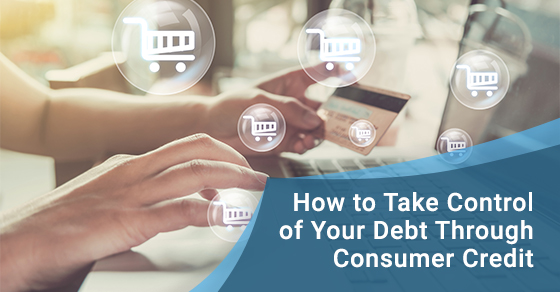
How to Take Control of Your Debt Through Consumer Credit
These days, more and more Canadians are finding themselves landing in debt. According to the most recent report from Equifax, Canadian consumers increased their winter credit significantly in 2019, as well as remained highly reliant on debt.
The report concluded the following: “The average debt per Canadian consumer (including mortgages) reached $71,300 in the first quarter of 2019, an increase of 2.6 percent over the same period last year. The proportion of Canadians posting higher credit balances compared to the previous year also reached a seasonal peak of 33.9 percent, up significantly from 2018.”
One of the most common sources of debt that lands many people into trouble is consumer credit — also known as consumer debt. When it comes to consumer credit, you’ll want to familiarize yourself with the process and various types so you can take control of your debt and financial future.
What is consumer credit?
If you’re unfamiliar with the term consumer credit, it’s a type of debt that a consumer takes on as a way to purchase goods and services. For example, a credit card would be considered consumer credit. This type of credit generally refers to purchases or services you would require on a daily basis, and not any long-term investments like the purchase of a house through a secured mortgage loan.
What sources offer consumer credit?
Many people find themselves seeking out short-term or long-term money solutions. If you are someone who needs to acquire credit, here are the most common sources that offer consumer credit:
Commercial Banks
Commercial banks offer loans to borrowers in the position to be able to repay them. For a basic definition of loans, they are the sale of money to be used by the lender — in this case, a commercial bank — and those who are seeking it out. Banks can offer various types of loans, like credit card loans, housing loans, and consumer loans.
Credit Unions
Credit Unions are nonprofit companies that offer lower costs and better loan terms than more commercial providers. They are known for offering good value for personal loans, as well as savings accounts.
Many of these firms take a certain amount of loan payments and savings installments from their members’s pay cheques and apply them directly to their credit union accounts. Credit Unions generally require qualifications that are less strict and can provide quick loan services.
Types of Consumer Credit
Now that you have a background about consumer credit and its various sources, it’s essential to know what types of consumer credit exist. Once you’re able to differentiate between the various types of credit, you’ll have a better idea of how you can successfully manage debt.
Non Installment Credit
Non Installment credit can be secured or unsecured, depending on the source or company offering the credit. This type of consumer credit’s full amount owed is due all at once in a lump sum payment. For the most part, non installment credit runs over a shorter period of time.
Installment Closed-End Credit
Installment closed-end credit offers a consumer a certain amount of credit so that they are able to purchase what they need, whether it’s once or a few items. A common example of an installment closed-end credit is a car loan.
This type of credit is offered by the car company to the person purchasing the vehicle, and the credit will never extend beyond the price of the car. The borrower will pay back the credit in installments over a defined period of time.
Revolving Open-End Credit
Revolving open-end credit is the type of consumer credit that results from a credit card. How this works is the consumer specifies the amount of credit they can use at their disposal.
Next, the consumer is required to pay off part of this credit during a specific timeframe, most commonly for one month. This type of credit generally does not close, only if the credit card company shuts down the account. However, for the majority of the time, the credit is revolving.
Throes of Debt
Now that you know the basics of consumer credit, you can take a look at your financial goals and create a money management plan. If you’re already in the throes of debt and are looking to get out, you may need to take the next step and consult a Debt Management Service.
Debt Solutions
If you’re not breaking even and depending on credit more and more, then you’re headed down a dangerous path. First, look for every area where you can make cuts, based on the same things mentioned above. In the case where you are overwhelmed and lost control of your financial situation then first do not panic because help is available for you.
At Charles Advisory Services, we work with individuals, corporations, and small businesses looking for debt solutions.We understand that an individual may face financial hardship in life due to job loss,sickness,death or family issues and your financial plan can fail unexpectedly.
We respect and understand that life can bring different challenges for different people.
Our team is here to offer free consultation.
We will work with your individual needs so that you don’t have to stress over rebuilding your credit or financial situation.
To learn more about the different types of consumer credit & for free professional consultation call Charles Advisory Services at 416-486-9660 or contact us here.

Leave A Comment